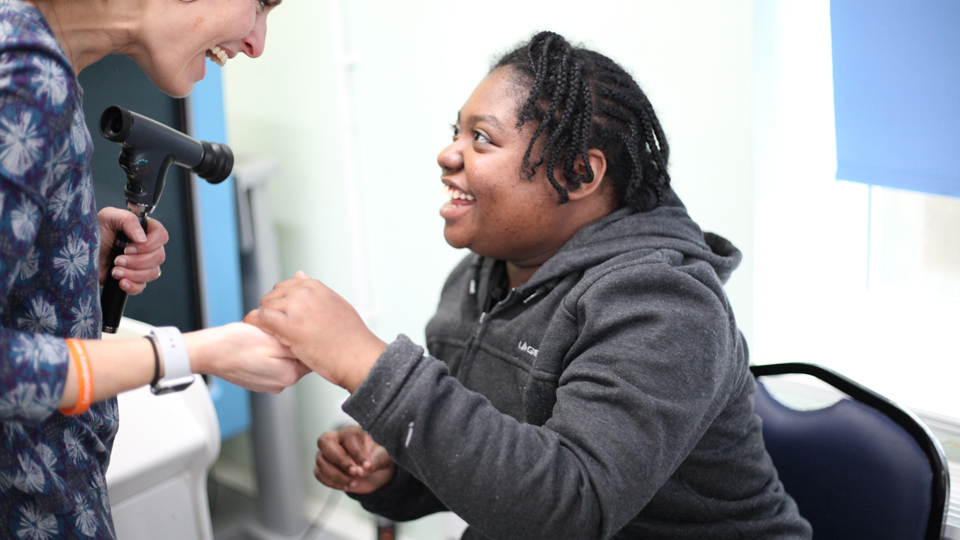How do I…
Adapt sight tests for patients with special needs
Optometrist and SeeAbility head of eye health and clinical lead, Lisa Donaldson, shares tips on adapting an exam to meet the needs of a patient with learning disabilities

Lisa Donaldson
20 September 2021
Optometrists should always be aware before they go to the waiting room to collect a patient if they are expecting to see someone with learning disabilities.
If at all possible, practice staff should provide the patient with a Telling the optometrist about me form, which is available to download on the SeeAbility website, to fill out at the time of booking. This will allow patients to sit at home with a carer or supporter and fill out details of their eye history and medical history, as well as what the current issues are before the eye examination. This both enables you as an optometrist to be prepared for the patient, but also means that valuable chair time isn’t wasted talking through these things.
If time permits before the eye examination, arrange a time for the patient and their carer or supporter to visit the practice to look around. Allow them into the testing room so they can familiarise themselves with the space and equipment. We call this an acclimatisation visit. It can help put the patient at ease in an environment that is unusual for them and make them feel much more comfortable when they later attend for the test.
I also often do everything twice. The first time I will perform the task on the carer or supporter, and the second time I will do it on the patient. This means that there are no surprises as they have seen the test happen
In the testing room
In the testing room, when examining the patient, try never to talk over them. Talk to them directly, even if you are not sure that they understand. I think talking a lot is good as it tends to put the patient at ease if you are constantly explaining to them what you are going to do next.I also often do everything twice. The first time I will perform the task on the carer or supporter, and the second time I will do it on the patient. This means that there are no surprises as they have seen the test happen. This is something that I do when testing children in special schools with SeeAbility also; a child will come along with a friend who has already had an eye test and they can watch their friend go first.
Allow them to touch some of the equipment, such as the acuity glasses or stereotest, before you use it, so they are familiar with what each tool looks and feels like.
Be sure to explain as you go through each step of the test what you are doing. For example, ‘I’m just going to shine this light in John’s eye, can I shine it in yours next?’ This also ensures that you are getting consent at every step of the journey.

When testing this patient group, you have to be skilled in retinoscopy, which many optometrists can be rusty on due to the increased use of autorefractors, so practice beforehand if it isn’t something that you use in day-to-day practice.
On a clinical note, when testing this patient group it is really important to make sure that you consider accommodative insufficiency. Don’t assume near vision is going to be ok. I would recommend doing dynamic retinoscopy on everyone in this patient group as a high percentage will need a reading addition, which is very unique in this population.
There is no shame in asking how the patient communicates as this will help you to adapt your routine
Communication is key
Understanding how the patient can and wishes to communicate with you is really important. Some people who can’t verbally communicate can still understand everything that you are saying. There is no shame in asking how the patient communicates as this will help you to adapt your routine.
While talking lots can be useful, be sure not to talk too quickly. It is important to give the patient time to process what you are asking. There must be nothing more frustrating for the patient than being asked, ‘Can you see that?,’ and as they are about to answer, the optometrist responds, ‘And what about this?’ The patient may have answered the first question if you had just given them a little more time than normal to respond. Generally, when asking questions to patients I wait for eight, by which I mean I count eight seconds before following up and asking another question.
When explaining things, I would seek to explain everything both verbally and visually. Using gestures is really important as well.
Statistics report that we only remember 60% of what we are told, so allow and encourage the patient to write things that you explain down.
After the examination, you can also write a report for the patient to take away that summaries your findings to help them and their supporter better understand their eye care needs. A useful tool for this is the SeeAbility Feedback from my optometrist form.
Finally, before they leave, remember to share any easy read resources with the patient that sign post them to more information about their eye care. SeeAbility has a range of easy read downloadable eye health information forms available on its website.
Three steps to success
- Have patients fill in a Telling the optometrist about me form before their appointment so you are aware of their eye history
- Explain everything you are doing and perform each test on their supporter first
- Don’t talk too quickly and give the patient time to respond – wait for eight seconds before asking the next question.

Comments (0)
You must be logged in to join the discussion. Log in